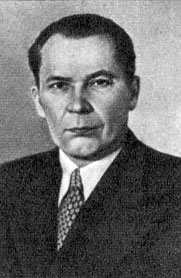Maksim Saburov
| Maksim Saburov Максим Сабуров |
|
|---|---|
 |
|
| First Deputy Chairman of the Council of Ministers of the Soviet Union | |
|
In office 28 February 1955 – 5 July 1957 |
|
| Premier | Nikolai Bulganin |
| Preceded by | Mikhail Pervukhin |
| Succeeded by | Joseph Kuzmin |
| Chairman of the State Economic Commission on Current Planning | |
|
In office 25 May 1955 – 25 December 1956 |
|
| Premier | Nikolai Bulganin |
| Preceded by | None (Himself as State Planning Chairman) |
| Succeeded by | Mikhail Pervukhin |
| Chairman of State Planning Committee of the Soviet Union | |
|
In office 29 June 1953 – 25 May 1955 |
|
| Premier | Georgy Malenkov |
| Preceded by | Grigory Kosyachenko |
| Succeeded by | Nikolai Baibakov |
|
In office 5 March 1949 – 5 March 1953 |
|
| Premier | Joseph Stalin |
| Preceded by | Nikolai Voznesensky |
| Succeeded by | Grigory Kosyachenko |
|
In office 10 March 1941 – 8 December 1942 |
|
| Premier | Joseph Stalin |
| Preceded by | Nikolai Voznesensky |
| Succeeded by | Nikolai Voznesensky |
| Full member of the 19th, 20th Presidium | |
|
In office 16 October 1952 – 27 February 1957 |
|
| Personal details | |
| Born | 2 February 1900 Druzhkivka, Russian Empire |
| Died | 24 March 1977 (aged 77) Moscow, Russian SFSR, Soviet Union |
| Citizenship | Soviet |
| Nationality | Ukrainian |
| Political party | Communist Party of the Soviet Union |
Maksim Zakharovich Saburov (Russian: Максим Захарович Сабуров, 2 February 1900 – 24 March 1977) was a Soviet engineer, economist and politician, three-time Chairman of Gosplan and later First Deputy Premier of the Soviet Union. He was involved in the Anti-Party Group's attempt to displace Nikita Khrushchev in 1957.
Saburov was born in 1900 in the town of Druzhkivka in what is now Ukraine. He joined the Communist Party in 1920, serving in a detachment with the aim of suppressing resistance to the Communist regime. He attended the Sverdlov Communist University between 1923 and 1926, then studied to become an engineer at the Bauman Moscow State Technical University in Moscow.
Between 1921 and 1926, Saburov was Secretary of the Bachmut Komsomol Committee, and then that of the Kostiantynivka raion. Between 1926 and 1928, Saburov was a propagandist working in the Donets region. After five years of studying at the Bauman Institute, Saburov became head of the technological bureau of a factory in Moscow in 1933. Subsequently he was head of the instrumental division of the Stalin Novokramatorsk Machine Plant until 1937.
Saburov advanced rapidly during the Great Purge, becoming a minister in the Narkomat for Heavy Machines in 1937, and then Gosplan Secretary for Machinery in 1938.
In 1940, Saburov became First Deputy Chairman of Gosplan, the committee responsible for planning the Soviet economy, giving him wide-ranging powers over the Soviet economic apparatus, marking the beginning of the most notable period of his career in the Party. In 1947, Saburov became a member of the Supreme Soviet of the USSR and in 1952 he became a member of the Central Committee of the CPSU. He served in the Presidium of this body until 1957, and he left the Committee in 1961.
...
Wikipedia
